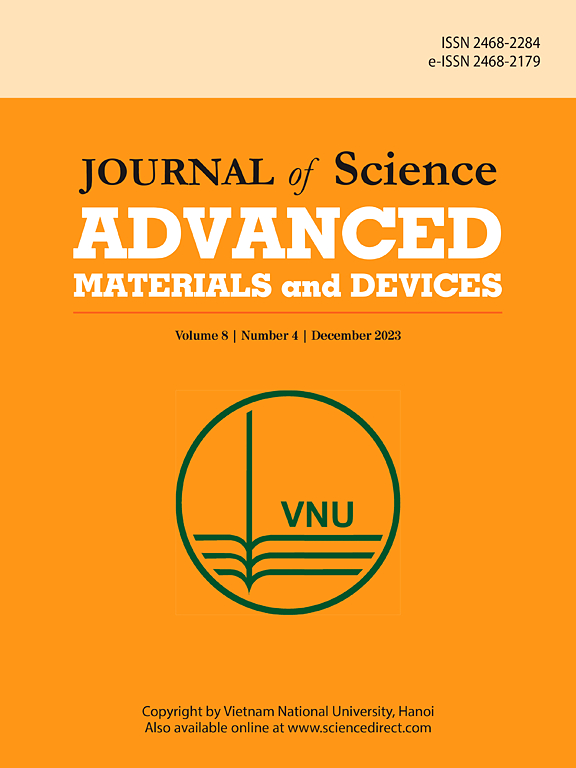Magnetic and pH-Sensitive dual actuation of biohybrid microswimmer of targeted drug release suitable for cancer cell microenvironment
IF 6.7
3区 材料科学
Q1 MATERIALS SCIENCE, MULTIDISCIPLINARY
Journal of Science: Advanced Materials and Devices
Pub Date : 2025-02-27
DOI:10.1016/j.jsamd.2025.100873
引用次数: 0
Abstract
The chemotherapeutic agents most frequently used in cancer treatment often have limited effectiveness because of their low specificity for tumors and poor therapeutic performance. In addition to the aforementioned therapeutic challenges the drug delivery carriers conjugated with the drug encounter early detection and elimination from the immune system before arriving at the affected area continues to be a significant research focus among researchers. To address this prevalent issue, an effective approach has been developed that leverages the physiological differences between normal and tumor tissue to enhance the efficacy of anticancer drugs. This drug delivery system is designed based on pH-sensitive drug release, ensuring targeted release within cancer cells. In the present study, we have developed a drug carrier called as biohybrid magnetic microswimmer (BMM). The BMM was formed through a three-step process: firstly, bacterial surfaces were functionalized with biotinylated PEG which enables the bacteria to escape the phagocytosis process; secondly, the anticancer drug lenalidomide was PEGylated to enhance solubility; and finally, both complexes were conjugated via streptavidin-biotin interaction. The study investigated bond formation, bacterial viability after drug treatment, pH-dependent release, and cytotoxicity in various cell lines (MCF-7 and THP-1 cells), and the results revealed that the concentration of the drug, released from BMM gradually increased as the pH of the solvent decreased from neutral to acidic, mimicking the surrounding environment of normal cells and cancer cells, respectively, which in turn affects the cancer cell viability negatively. Therefore, BMM shows promise in targeted drug delivery, utilizing magnetic manipulation and pH-triggered release, providing advantages that include bacteria's maneuverability and PEG's stealth properties, enhancing drug efficacy.
适合癌细胞微环境的靶向药物释放生物杂化微游泳器的磁敏和ph敏双驱动
在癌症治疗中最常用的化疗药物由于其对肿瘤的低特异性和较差的治疗效果往往有限。除了上述的治疗挑战外,与药物结合的药物递送载体在到达患处之前会被免疫系统早期发现和消除,这仍然是研究人员的一个重要研究重点。为了解决这个普遍存在的问题,一种有效的方法已经被开发出来,利用正常组织和肿瘤组织之间的生理差异来增强抗癌药物的功效。该给药系统是基于ph敏感性药物释放设计的,确保在癌细胞内靶向释放。在本研究中,我们开发了一种称为生物杂交磁性微游泳体(BMM)的药物载体。BMM是通过三步过程形成的:首先,细菌表面被生物素化的聚乙二醇功能化,使细菌能够逃避吞噬过程;其次,将抗癌药物来那度胺进行聚乙二醇化,提高其溶解度;最后,通过链霉亲和素-生物素相互作用将两种配合物偶联。本研究考察了多种细胞系(MCF-7和THP-1细胞)在药物处理后的键形成、细菌活力、pH依赖性释放和细胞毒性,结果表明,随着溶剂pH从中性降至酸性,BMM释放的药物浓度逐渐增加,分别模拟了正常细胞和癌细胞的周围环境,从而对癌细胞活力产生负影响。因此,BMM在靶向药物递送方面显示出前景,利用磁操纵和ph触发释放,提供包括细菌可操作性和PEG的隐身特性在内的优势,增强药物功效。
本文章由计算机程序翻译,如有差异,请以英文原文为准。
求助全文
约1分钟内获得全文
求助全文
来源期刊

Journal of Science: Advanced Materials and Devices
Materials Science-Electronic, Optical and Magnetic Materials
CiteScore
11.90
自引率
2.50%
发文量
88
审稿时长
47 days
期刊介绍:
In 1985, the Journal of Science was founded as a platform for publishing national and international research papers across various disciplines, including natural sciences, technology, social sciences, and humanities. Over the years, the journal has experienced remarkable growth in terms of quality, size, and scope. Today, it encompasses a diverse range of publications dedicated to academic research.
Considering the rapid expansion of materials science, we are pleased to introduce the Journal of Science: Advanced Materials and Devices. This new addition to our journal series offers researchers an exciting opportunity to publish their work on all aspects of materials science and technology within the esteemed Journal of Science.
With this development, we aim to revolutionize the way research in materials science is expressed and organized, further strengthening our commitment to promoting outstanding research across various scientific and technological fields.
 求助内容:
求助内容: 应助结果提醒方式:
应助结果提醒方式:


